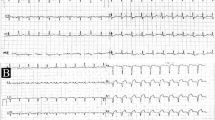Abstract
Herbal intake is escalating worldwide. To the best of our knowledge, myocardial infarction (MI) has not been reported following ingestion of laxative herbs in the absence of the well known risk factors for MI. We report on a 45-yr-old female patient who sustained acute inferior MI 8 h following Cassia italica ingestion. Subsequently, cardiac catheterization revealed patent coronary arteries. We assume that, in this case, MI may partly be related herbal ingestion. Further studies and public awareness of this complication in certain communities are needed.
Similar content being viewed by others
References
Valli, G. and Giardina, E.V. (2002). Benefits, adverse effects and drug interactions of herbal therapies with cardiovascular effects. J. Am. Coll. Cardiol. 39:1083–1095.
Haller, C.A. and Benowitz, N.L. (2000). Adverse cardiovascular and central nervous system events associated with diatry supplements containing ephedra alkaloids. N. Engl. J. Med. 343:1833–1838.
Agarwal, S.C., Crook, J.R., and Pepper, C.B. (2006). Herbal remedies—how safe are they? A case report of polymorphic ventricular tachycardia/ventricular fibrillation induced by herbal medication used for obesity. Int. J. Cardiol. 106(2):260–261.
Lumb, A.B. (1994). Effect of dried ginger on human platelet function. Thromb. Haemost. 7:110–111.
Al Araidh, I.A., Al Aufail, M.A., and Al Jammaz, I.A. (2004). Toxicity of cassia italica seeds to rats. Kuwait Sci. Eng. 31(2):147–154.
Bakhiet, A.O. and Adam, S.E.I. (1996). Toxicity to bovan chicks of Cassia italica seeds. Phytother. Res. 10:156–160.
Adam, S.E.I., Al-Yahya, M.A., and Al-Farhan, A.H. (2001). Combinedtoxicity of Cassia senna and Citrullus colocynthis in rats. Vet. Hum. Toxicol. 43:70–72.
Bradley, P.R. ed. (1992). British Herbal Compendium, Vol 1. BHMA, Bournemouth, UK: pp. 199–203.
Mills, S.Y. (1991). Essential Book of Herbal Medicine. Penguin Books. London: p. 289.
Assane, M., Nydyema, R., Bassene, E., Sere, A., and Gaye, O. (1994). Purgative activity of Cassia italica. Dakar Med. 39(2):125–128.
Ali, B.H., Bashir, A.K., and Tanira, M.O. (1997). Some effects of Cassia italica on the central nervous system in mice. J. Pharm. Pharmacol. 49(5):500–504.
Author information
Authors and Affiliations
Corresponding author
Rights and permissions
About this article
Cite this article
El-Menyar, A.A., Helmy, A.H., Mubarak, N.M. et al. Acute myocardial infarction with patent epicardial coronary vessels following Cassia italica ingestion. Cardiovasc Toxicol 6, 81–84 (2006). https://doi.org/10.1385/CT:6:2:81
Received:
Revised:
Accepted:
Issue Date:
DOI: https://doi.org/10.1385/CT:6:2:81




